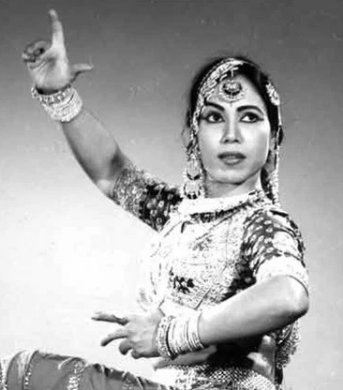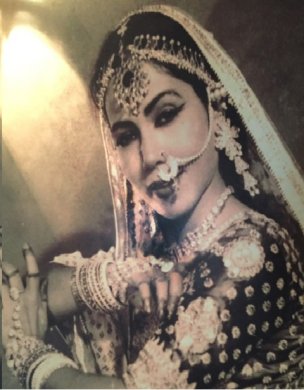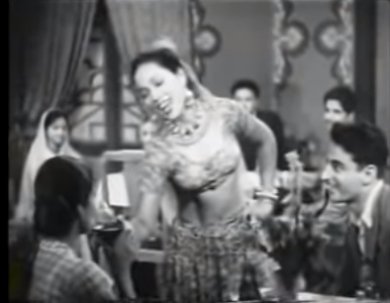 |
  |
 |
  |
Gender, Nationalism: Sitara Devi - The Fiery Queen of Kathak - Navina Jafa e-mail: navina.jafa@gmail.com November 4, 2019 Remembering Sitara Devi on her birth anniversary on 8th November, the Queen of Kathak dance is as much about her fiery personality as it is about locating the legendary dancer in a wider frame. Hers is a story representative of women empowerment in the Indian performing arts, about middle-class 'respectability' and about culture during the National Movement against the British. My meeting with enigmatic Sitara It was a cold winter evening in Varanasi in 1996, when I learned that Sitara Devi, Didi as she was to all of us young dancers, was in town and was staying in her ancestral home in Kabir Chaura, where most of Kathaks traditionally lived. I called to ask for an appointment and she ordered me to visit her at 7.30am. I was there on the dot and when the door opened into a dark verandah facing a courtyard, I was a little startled to see on the dining table, a bottle of whiskey and two used glasses. In the corner, a bulb hung miserably, but below that standing still, in all her stage glory with makeup, costume, ghungaroos, stood Sitara Devi. "So you have learned from Birju Bhaiya? (Pandit Birju Maharaj)... but do you know what my family's importance is? No! I am sure you do not because all you can see is Birju Bhaiya..." In the two very long interviews I had with her in Varanasi and then in Delhi, emerged a significant amount of information that would help in comprehending the history of the main classical dance of North India - Kathak. The Caste and Gender: The Kathaks  Sitara Devi was born into the house of traditional performing artists belonging to the community of 'Kathaks'. The Kathaks are considered Brahmins but of lower category, they cannot receive daan (gifts), or perform any sacred rituals but are allowed to perform Katha (enacting mythological stories in people's houses, or temple courtyards), according to the former Mahant (priest) of the Kashi Vishwanath Temple, Varanasi, and priest Nankphopha from Gaya. Sitara Devi's father Sukhdev Maharaj initiated his three daughters into the performing space when ladies of the stage were always the tawaifs (courtesans) who after 1857 were perceived not as performers but as mere entertainers and even prostitutes. However, this bold step was well strategized even at the cost of being ostracized by his own community. The patronage of the stage at that time was confined to the aristocracy or the temple authorities. Sukhdev Maharaj was not backed by any prominent aristocrats and wanted them to achieve recognition in their own right and earn respectability for the profession. In Kathak dance, until the 1950s majority of performers were the women tawaifs, but the power to transmit the art was with the male gurus. The technical repertoire of the male dancer was significantly different from what tawaifs performed which was framed within the context of the enactment of largely sophisticated sensual poetic imagery through music and multi-layered interpretative language of gestures (abhinaya). The entire objective of the performance of the tawaif was to entrance the clients and earn a livelihood through performance. It may be noted that there was a caste system within the tawaifs and high ranked tawaifs were supreme performers and not prostitutes. Yet they were perceived as such which is why the entry of Sitara and her sisters on stage was a step towards providing the Kathak dance 'respectability.' Sukhdev Maharaj planned for his daughters not only to learn what usually was performed by the male dancers, but he also drew the content of the natya or the expressive aspects of their dance from symbols, and literature of Hindu Mythology. He had served in the court of Nepal and was greatly influenced by the Shaivite tradition. Of her sisters, Sitara was the favorite of her father, and the most adept. In one of her interviews, she said to me, "My father would simply draw from the mythological sacred content referring to both traditions of Vaishnavism and Shaivism. He would create compositions, dance dramas from the leelas of Rama, Krishna, Bhagwan Shiva. The vibrancy of these gods would resound in the mnemonic syllables, and use of poetic language, or in the songs chosen... We were Brahmin girls... and even as we understood and performed shringar (a reference to erotic poetry), my father insisted on the interpretation that went beyond the erotic into the world of metaphysical..." The National Movement - Kathak as a classical dance form  The period between the 1920s and 1940s can be considered as the watershed decades of Indian dance. Several prominent performing arts institutions like Kalakshetra, Sangeet Bharati, Kerala Kalamandalam, and Shantiniketan were established and became the spaces for a frenzy of sociological and aesthetic movements in classical dance forms. Both the institutionalization as well as the remolding of aesthetics were important markers to the creation of new performers from respectable middle-class families and who were neither Devadasis (temple dancers) nor Tawaifs (courtesans), and these trends also contributed to a new phase of cultural nationalism. The Bhatkhande Music Conference of 1925 saw, for the first time, a dance performance by the Kathak maestro Shambhu Maharaj. More important though was that in the formal pamphlet, the dance, and not the dancer as a representative of a performing caste community, was addressed as Kathak. The formal recognition of the dance and aligning it with a high caste identity was in some ways an assertion for providing the dance the notion of respectability. In 1945, the first Dance Festival was organized in the Feroz Shah Kotla Ground, Delhi, and was organized by the first secretary of the Sangeet Natak Akademi, Nirmal Joshi. Achhan Maharaj, father of Pandit Birju Maharaj, was commissioned to create two dance-dramas in Kathak, one was an adaptation of Kalidas's Sanskrit drama Kumarasambhavam, and the other Braj Leela. Choice of Sanskrit and sacred dramas was again an attempt towards the creation of Kathak as a respectable dance that was aligned to the classical language Sanskrit and the sacred Vaishnav realm and in the process, Kathak was hoped to gain a respectable status far removed from the world of tawaifs. Locating Sitara as part of National Freedom Struggle At this time Sitara Devi's appearance on the stage was almost revolutionary. And it is in this context and the context of reclaiming cultural space that fitted into a larger framework of a reconstructed respected aspect of Cultural Nationalism. Many eulogies have been written after her death at the ripe age of 92, but Sitara Devi will live through the hundreds of young girls from "respectable" families who learn Kathak and aspire to be performing on stages nationally and internationally.  Sautan ke ghar na jayo Her personal imprint on the actual performance of Kathak will always be that of a performer who when performing gave the audience a glimpse of liberation, where she abandoned and transcended the body, which made the maestro Pandit Birju Maharaj tell me, "If there is one woman who goes beyond the woman's body and dances like a man, it is Sitara...!" It reminds me of what the 13th c Sufi Saint Hazrat Nizamuddin said of an extremely powerful woman Sufi saint of Delhi - Hazrat Bibi Fatima Sam - "When a lion emerges out of the forest, nobody asks if it is male or female..." Sitara went much beyond the time in which she was born; she evolved as a completely de-institutionalized woman who through her bold energy asserted herself on the contemporary stage. She redefined the mold of the traditional woman performer. While on stage, she combined the male and female energies, vigorous and bold to the extent of defiance, completely shameless but covered in the intoxication of sacred pulses. A woman in whose body collapsed various rhythms of time and history, that one could recall Yeat's famed lines... "Labour is blossoming or dancing where, the body is not bruised to pleasure soul. Nor beauty born out of its despair, Nor blear-eyed wisdom out of midnight oil.... O body swayed to music, O brightening glance, How can we know the dancer from the dance?" Yes, one can hear her soul still dancing somewhere in the sky above. Navina Jafa did her Phd on socio-economics, and aesthetics in the world of Kathak Dance in 6 urban towns of North India under Dr. Kapila Vatsyayan and urban historian Prof. Narayani Gupta. She learned Kathak from Gurus Pt. Birju Maharaj, Munna Shukla and Reba Vidyarthi. A Fulbright scholar at the Smithsonian Museum, she worked on cultural management and diplomacy. She runs a business on Academic Tourism and is vice president of Centre for New Perspectives presently working to create sustainable livelihoods for marginalized street-folk performers. (www.navinajafa.com) Comments * Erroneously or inadvertently, budding dance writer Navina Jaffa has stated "1945.... First dance festival.... Under first Secretary of SNA, Nirmala Joshi ... Not correct or possible. India was born in 1947! SNA was set up much later by an Act of the Parliament. Same para wrongly states Pt. Achchan Maharaj choreographed 2 ballets for this festival (which actually was 1954/55; maybe digits got interchanged.) Fact is he died in 1947. I have heard of ghost writers but never of ghost choreographers! Navina has got dates and facts all mixed up and should be more circumspect and careful in future,if serious about writing on dance history. Such flippant writing can be quite damaging to a researcher, reader or PhD student, who might quote from here. (Ashish Mohan Khokar, Dec 19, 2019) * I wish to categorically clarify on the comment by Mr. Ashish Khokar. As a full fledged trained historian it is my legal responsibilty to clarify and respond. 1. The year is 1945 given as an interview by Dr. Kapila Vatsyayan where I was shown also a newspaper cutting. Acchan Maharaj died two years later (unfortunate heat stroke) 2. Of course SNA was formed in the 1950s but this program was organized by Nirmala Joshi who was already extremely active in the cultural patronage scene in Delhi and running a Hindustani school of music and dance where Achhan Maharaj was teaching and likes of sarod maestro Sharan Rani was learning. I appreciate Mr. Khokar’s concern but I too have a right to clarify. (Navina Jafa, Dec 20, 2019) * Sir, as a trained historian, and now in 50s I think I am no longer young or budding! 1945 was the first festival NOT by SNA but under the aegis of Sangit Bharti. My training as a historian does not quite allow for not only checking facts, but checking out primary material. Regards Dr. Navina Jafa (April 2, 2021) Post your comments Please provide your name and email id along with your comment. All appropriate comments posted with name and email id in the blog will also be featured in the site. |